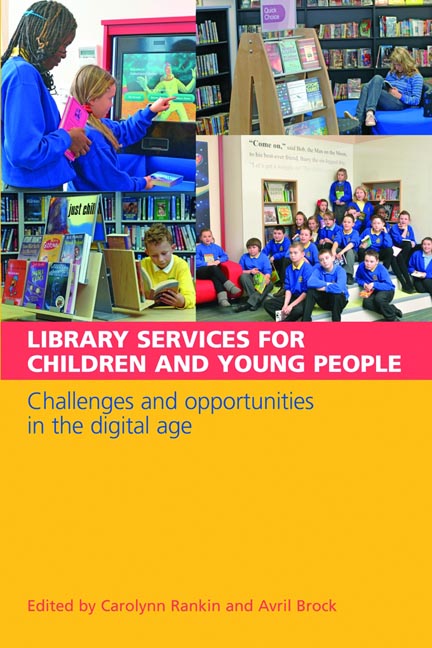Book contents
- Frontmatter
- Dedication
- Contents
- Contributors
- Foreword
- Acknowledgements
- Introduction and vision for the book
- Part 1 Children's library services – policy, people and partnerships
- Part 2 Connecting and engaging – reaching your audience and catching the latest wave
- Part 3 Buildings, design and spaces – libraries for children and young people
- Part 4 Issues for professional practice
- 14 The importance of service evaluation in libraries for children and schools
- 15 The rights of the child and youth advocacy – issues for professional practice in the library setting
- Index
15 - The rights of the child and youth advocacy – issues for professional practice in the library setting
from Part 4 - Issues for professional practice
Published online by Cambridge University Press: 08 June 2018
- Frontmatter
- Dedication
- Contents
- Contributors
- Foreword
- Acknowledgements
- Introduction and vision for the book
- Part 1 Children's library services – policy, people and partnerships
- Part 2 Connecting and engaging – reaching your audience and catching the latest wave
- Part 3 Buildings, design and spaces – libraries for children and young people
- Part 4 Issues for professional practice
- 14 The importance of service evaluation in libraries for children and schools
- 15 The rights of the child and youth advocacy – issues for professional practice in the library setting
- Index
Summary
Introduction
Arts Council England has the responsibility for championing, developing and investing in libraries in England and states that access to knowledge, experiences and treasures within libraries is every child's birth right (Arts Council England, 2011). Children have a basic need to find out information, and the information that they gain is essential for individual development. They can use the information they obtain to change their circumstances, function better in society and be informed individuals, who can contribute to social change:
Libraries deal with human values protected by human rights. This basic truth seemed to have been somewhat forgotten or put aside by more conventional talk about all kinds of professional matters. But the notion of human rights as fundamental to libraries’ aspirations and core activities is increasingly receiving attention. (Koren, 2000, 273)
Koren makes a valuable and worthwhile point, in reminding us of the importance of libraries and the close relationship that they have with fundamental human rights. In this chapter, the primary consideration will be the rights of the child and youth advocacy and their relationship to professional practice in the library setting. This is not a new issue for the professional librarian, though the issue might well be considered as such, in view of the complexity of a global society, with internet access and the opportunity for instant communication, particularly through social networking. The ethical, moral and philosophical conundrums daily faced by librarians in schools, public libraries and in supporting and advising on work with children and young people provide constant operational and practical questions.
The reality for the professional librarian is that in carrying out their daily duties, they have to consider access, stock management, purchasing management, censorship, the cultural and social make-up of the community that they serve, professional ethics, the values and policies of their organization and myriad of small, daily interventions in their workplace. On a day-to-day basis, these are just part of the job, and the professional skills and personal judgement that are applied are, also, simply parts of the job. Historically, there have been tensions concerning the types of collection that should be available to the public or that should be stored behind closed doors, debates about censorship and freedom of speech and the ever-nagging question of what was suitable or appropriate for children.
- Type
- Chapter
- Information
- Library Services for Children and Young PeopleChallenges and opportunities in the digital age, pp. 221 - 242Publisher: FacetPrint publication year: 2012
- 1
- Cited by

